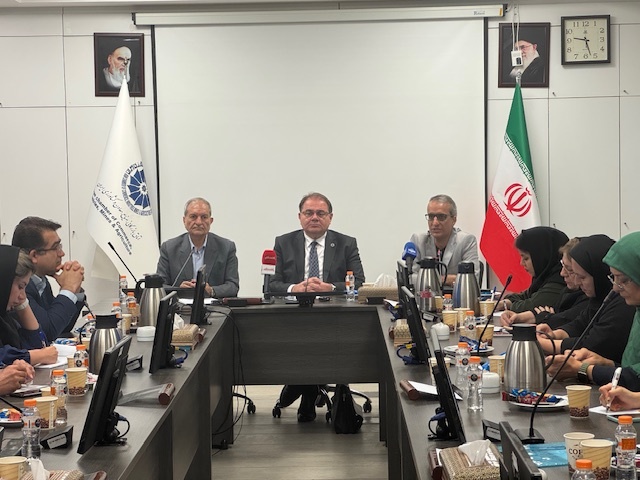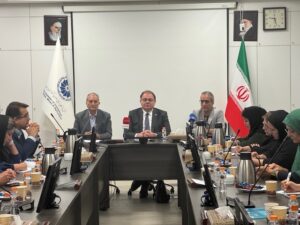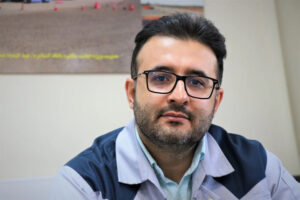According to Farda Ekhtaz report, the head of Iran’s Renewable Energy Association said at the meeting of the Energy Commission of the Iran Chamber and the Renewable Energy Association: the electricity shortage in the peak of 1402 was about 12,443 megawatts, which reached about 18,000 megawatts in 1403. That means we need 15 billion dollars of investment and 20 billion dollars with network, post and capital transfer; However, investors are facing many problems, including inadequacies in providing financial resources and currency, and the implementation inconsistencies in the government have added to these issues.
Referring to the challenges of lack of electricity in 1403, Daoud Madadi added: Considering the trend of increasing annual consumption, which has reached 5%, in 1422 we will need an electricity production capacity equal to 162 thousand megawatts. At peak times, this requirement will reach 200,000 MW, while our current capacity is only 91,000 MW. This means that we will face a production deficit of 110,000 megawatts.
He pointed out the problems of supplying fuel carriers and clarified: if we produce 50,000 megawatts through thermal power plants, we will face a shortage of 60,000 megawatts of electricity. To overcome this problem, we need extensive investment and activities to compensate for this deficiency.
The Chairman of the Board of Directors of the Renewable Energy Association of Iran noted: In the seventh development plan, the goal of creating 12,000 megawatts of renewable resources has been set, which includes 1,800 megawatts of solar power and 600 megawatts of wind power. To realize this goal, we need to invest 1.62 billion dollars, 70% of which should be provided from foreign exchange sources.
Referring to the upcoming conference held by Iran’s Renewable Energy Association on October 10th and 11th, he announced that with the presence of the responsible officials and the discussion of challenges and problems, they should play their role in solving the deficiencies. We hope that with common thinking and synergy, we can overcome the existing challenges and contribute to the sustainable development of renewable energy in the country.
Madadi emphasized: the government should reduce the entrepreneurship in the field of electricity and renewable energy to ensure the private sector’s confidence. In the government, the ownership of the investor and the producer should be recognized and partiality should be prevented. It should also put the issue of removing obstacles to electricity production on the agenda. It should use different capacities to provide financial resources. Currently, the distribution of currency is in the hands of Samat, and this ministry prioritizes its industries, not electricity. The government should separate the currency of the Ministry of Energy for the development of renewables from the Ministry of Security.
Electricity industry to investment ۲۰ It needs billions of dollars
The secretary of the Iranian Renewable Energy Association also added in this meeting: “Last summer, we had 18,000 megawatts of electricity imbalance in the country, which is equivalent to the total electricity consumption of two or three neighboring countries of Iran.” In order to compensate this amount of electricity deficit, we need 20 billion dollars of financial resources to reach zero. If we do not consider the growth of electricity consumption next year, which is about 5-7% of the year’s decline, we will reach the zero point, but this assumption is impossible.
Mohammad Amin Zanganeh stated about the method of providing sustainable financial resources in the electricity and renewable energy industry: We do not have enough financial resources for this 20 billion dollars; The country’s banking system is under the microscope of the Central Bank, and the payment of defaulted loans is a priority. The National Development Fund has 20 billion dollars, which is used for the development of the entire country’s industry, and not only for the electricity industry. On the other hand, people do not trust the capital market, and this market does not have enough depth, and financing from this market is difficult. There should be a discussion about the method of providing financial resources.
He continued: The main problem to solve the electricity deficit is the supply of power plant equipment, the method of providing financial resources should be in foreign currency, but in the current situation of the country, the exchange rate is low. According to the seventh annual development plan, 2,400 megawatts of renewable power plants must be built, and this power plant has financial resources of one and a half billion dollars per year, of which one billion dollars must be in foreign currency; But in the situation of currency shortage, where should this amount of currency be provided?
The Secretary of the Renewable Energy Association of Iran stated: The government acts as an island in the field of solving the problem of electricity imbalance. The Ministry of Energy signs a contract with a company to build a power plant, but the Ministry of Silence does not register the order. It seems that the electricity problem in the country is not taken seriously or the government does not act as a unit. For example, last summer, a large amount of equipment was left in the customs and orders were not registered, and at the same time, the electricity of the industries was cut off, or the companies that imported panels and inverters into the country; But because they didn’t have the land to install them, the equipment was left in the warehouses, while we needed electricity production the most. On the other hand, getting permission to build a power plant takes time.
He pointed out: Another important problem is the request of the private sector from the government. An investor who cannot collect his money from the government, and his repayments are in trouble, the bank or the National Development Fund will recognize him as a bad customer, and the country’s financial system will be pessimistic towards investment.
Zanganeh continued: In order to achieve its goals, the renewable industry needs to define a stable financial flow that without the need for annual bargaining for the allocation of resources for this industry, including in Article 5 of the Electricity Industry Protection Law or Article 16 of the Knowledge-Based Production Jump Law, the investor of this industry can Be sure to receive the sale price of your electricity or the price of your saved fuel and enter this field.
He announced about the operational solution: despite the allocation of resources for the payment of renewable claims in the budget law of 1403 from Article 3 of the law on removing obstacles to the development of the electricity industry, this allocation has not been made and renewable power plants are still waiting for their natural rights from Article 16 of the law. They are trying to jump knowledge-based production and have not got results. A sustainable financial system should be considered for this industry.
The secretary of the Iranian Renewable Energy Association said about the launch of the green board of the Energy Exchange: the buyers of this board are big industries, not the government; The government should get out of the electricity industry and electricity trade, strengthen the green board, and the investor will be relieved so that the big industries will return their money and the system will remain stable, but if the government buys guarantees like before, it will not have enough resources and will cause a repeat of the crisis.
Prediction of 24,000 megawatt electricity deficit for next year in case of non-financing
The head of the Energy Commission of the Iran Chamber also noted in the meeting of the Energy Commission of the Iran Chamber and the Association of Renewable Energy: It is predicted that we will have a deficit of 24,000 megawatts of electricity for the next year; It is estimated that we will consume 17 billion dollars of liquid fuel in the power plant. That means we have fuel problems in summer and winter. Electricity imbalance is also an ongoing problem.
Arash Najafi continued: Petrochemical and steel industries will be deprived of gas for 60 to 70 days so that we can provide gas for homes and gas for thermal consumption. We should see what they have done in the world? We are the second gas-producing country in the world and we have advantages in all aspects, and this situation has no other reason than mismanagement and inaccuracy in methods.
He clarified: In 2008, the Supreme Leader stressed on reforming the consumption pattern. Unfortunately, none of the governments of the time paid attention to this, and today we have to economize and define thousands of processes to overcome crises.
The head of the Energy Commission of Iran Chamber called renewable energy as one of the effective and fruitful processes and added: the amount of sunlight in Europe is not comparable to ours, but they have reached the limit of 50% renewable, but we have reached 1,000 by consuming 75,000 megawatts of electricity annually for a total of 60 years. We have reached 1100 megawatts of electricity production. While with the financial model defined by the parliament, we should have brought 2400 MW into the circuit. Last year, the emirate operated 2,000 megawatts with one of its power plants in Cup 28. In our region, 20,000 megawatts of solar power plants have been set up.
He emphasized: The electricity industry is bankrupt and failure to pay electricity bills on time is very problematic. The 14th government is obliged to achieve 10,000 megawatts of electricity in four years. Pay the bills of electricity producers on time and we have to make demands in this direction.
The need to establish a regulatory body and regulate Garburq
Najafi said about the gap in the electricity regulator and regulatory body in the government: Monopoly everywhere, regardless of corruption, brings inefficiency; Buying, selling, pricing and distribution are monopolies and monopolies have hit the electricity industry. A regulatory body should be established to solve part of the problems of the electricity industry.
He pointed to the lack of sanctions in the field of renewable energy and said: the private sector can follow the issue in this field to international interactions and import renewable energy equipment. On the other hand, carbon certificate business can also be followed in this field.
The head of the Iran Chamber’s Energy Commission stated: the private sector can make productive investments; But this subject has prerequisites. The government should remove the barriers to investment in the electricity industry.
Inefficient laws in the electricity industry
In response to a question about ineffective laws in the electricity industry, Najafi said: Many laws in the electricity industry were written incorrectly from the beginning. According to Article 25 of the improvement of the business environment, the Ministry of Oil and Energy is obliged to pay the damages in case of power and gas cuts in industries. This law has been approved for 10 years, but not a single Rial has been paid for it. The government is unable to pay the electricity subsidy and it is natural that it cannot pay the damages of the industries. Hence, this law was written wrong from the beginning.
He continued: Another wrong law that exists in the electricity industry is Article 4 of the law on removing obstacles from the electricity industry. Industries are required to produce five percent of their electricity. This is despite the fact that power plant management is a specialized job and cannot be handled by industries.
According to the head of the Energy Commission of the Iran Chamber, the solution of the Iran Chamber is for industries to finance power plants instead of building them. With the efforts of the Iran Chamber, the industries are supposed to collect the necessary funds for the power plant and the power plants of 1,000 to 2,000 megawatts will be established with the efforts of the private sector. The shares of these producers are in accordance with Article 4 of the Anti-Barrier Law. These problems also exist in the field of gas, and industries were obliged to store for 15 days in winter, which imposes a serious cost on the production unit. These decisions are not wise and it has become clear over the past 45 years.
The 6th conference of Iran’s renewable power plants will be held on October 10th and 11th, 1403 in the large hall of Tehran Regional Electricity Conferences in Saadat Abad, Tehran, with the presence of investors, industrial owners, representatives of relevant government agencies, farmers and trade unions.
Iran Renewable Energy Association, Iran Chamber of Commerce, Industries, Mines and Agriculture, Ministry of Industry, Mines and Trade, Satba, Tavanir and other trade associations and government organizations cooperate in holding this two-day conference.
The 6th conference of renewable power plants in Iran is a good opportunity for investors, industries, farmers, government institutions, etc. to get acquainted with the conditions and methods of building solar and wind power plants, along with the economic review of renewable power plants.










